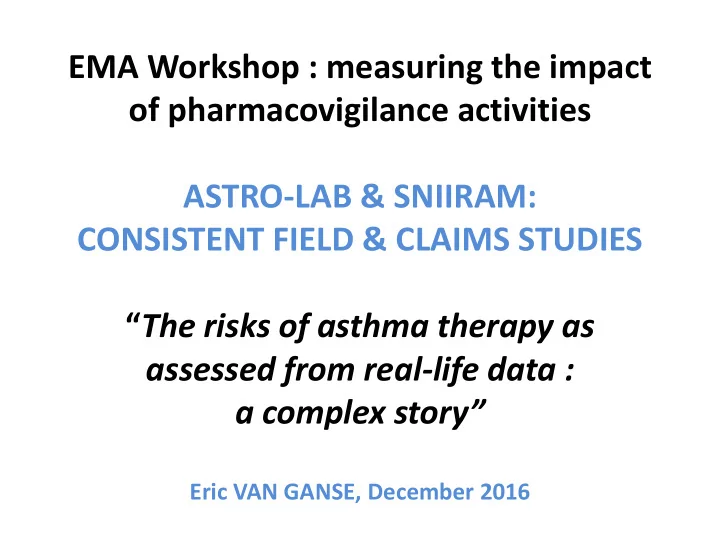

EMA Workshop : measuring the impact of pharmacovigilance activities ASTRO-LAB & SNIIRAM: CONSISTENT FIELD & CLAIMS STUDIES “ The risks of asthma therapy as assessed from real-life data : a complex story” Eric VAN GANSE, December 2016
« Proof of concept »: the Astro-lab study • Background : repeated safety signals re the effects of LABAs in asthma warnings/Dear Doctor Letters/guidelines, in addition to studies requested (FDA) or sponsored (EMA) by regulators • US : RCTs focused on fixed-dose combination (FDC): no increased risk • EU = ASTRO-LAB study= observational study, based on the hypothesis of a differential use LABA/ICS (when LABAs used outside FDC) • ASTRO-LAB field cohort : close monitoring at patient level of reported use of therapy and occurrence of adverse outcomes • Conclusions : LABAs alone (monotherapy and free combinations) increased the risk of adverse events, although non significantly so (“signal”), in contrast to FDCs (no increased risk)… support the differential use hypothesis 2 Assessment of the safety of long- acting β2 -agonists in routine asthma care: the ASTRO-LAB protocol. Van Ganse E, Texier N, Dima AL, Laforest L, Ferrer M, Hernandez G, Schuck S, Herbage S, Vial D, de Bruin M; ASTRO-LAB group. NPJ Prim Care Respir Med. 2015 Jun 18;25:15040.
« Confirmation » = studies of the patterns of use of asthma therapy, from SNIIRAM data (1/2) 1. “France vs. UK” : quantification of two patterns of use of therapy that put the patients at risk of adverse outcomes: • LABA use 'unbalanced' by co-therapy with inhaled steroids (differential use) • high SABA use • Based on these 2 criteria, > 190 000 patients aged 6 to 40 with inappropriate asthma therapy in France in 2013 (“at risk”) 3 Inappropriate asthma therapy-a tale of two countries: a parallel population-based cohort study. Belhassen M, Nibber A, Van Ganse E, Ryan D, Langlois C, Appiagyei F, Skinner D, Laforest L, Soriano JB, Price D. NPJ Prim Care Respir Med. 2016 Oct 13;26:16076.
« Confirmation » = studies of the patterns of use of asthma therapy, from SNIIRAM data (2/2) 2. Patterns of use of therapy recorded before admission to the hospital for an asthma exacerbation (Ward's minimum- variance hierarchical clustering method) Cluster 1 : 63,6% of patients with low exposure to ICS (1,20 units), to LABA (0,20 units), or to FDC (0,6 units) Cluster 2 : 32,4% of patients with high use of FDC (7,50 units) Cluster 3 ; 4,0% of patients with more use of LABA ( 8,20 units ) than ICS ( 5,40 units ): differential use 4 Level of Asthma Controller Therapy Before Admission to the Hospital. Belhassen M, Langlois C, Laforest L, Dima AL, Ginoux M, Sadatsafavi M, Van Ganse E. J Allergy Clin Immunol Pract . 2016 Sep - Oct;4(5):877 - 83.
Summary & conclusions of activities …Since 1993, repeated safety signals with LABA ASTRO-LAB hypothesis: signal is due to inappropriate patterns of use of therapy (prescribing by Health Care Professionals and/or use by patients) >>>> toxicity ASTRO-LAB = field study focused on patients behaviours & PROs: results suggest increased risk under non-FDC LABA vs. no adverse effect of FDC-LABA Ancillary studies using SNIIRAM data illustrate the high prevalence of inappropriate use of asthma therapy, and the relationship between LABA/ICS differential use and hospital admissions Next: to distinguish the roles of Health Care Professionals and patients, to improve Health Care Professionals’ training and patient education, to perform Public Health surveillance (SNIIRAM), and … to intervene when needed (for instance: poor « therapeutic ratios » at practice level) 5
2006: Salpeter 2011: the FDA 1990: LABAs 1993: Castle et et al. Meta- issues a safety launch al. PASS study analysis alert for LABAs 2010: EMA request for a LABAs safety study Figures from SNIIRAM data 6
Summary of PV activities around the use of LABA in asthma, & impact/ evaluation : a model? Claims Data 1. Investigations of a potential safety signal < LABA in asthma support the absence of toxicity, and emphasize the need to prioritize prevention of inappropriate patterns of use, i.e., the use of LABA without regular ICS coverage 2. Inappropriate patterns of use can be identified through automated SNIIRAM screenings (e.g., ratios), and practices/patients may be targeted 3. Inappropriate patterns of use may be prevented after raising Health Care Professionals’ awareness for EBM-prescribing (national/local guidelines) 4. Patient behaviour may be modified through associations (e.g., asthma UK), education (self-care, health literacy), and if needed, navigators 5. Impact of activities and possible re-orientations may be assessed from repeated SNIIRAM surveys 7
SNIIRAM: National French claims data SNIIRAM is the National Information System for the “French NHS” (all systems) • Implemented in 2006, SNIIRAM is a national database of all reimbursed • interventions (claims), with linkage at individual level between I care and II care Data available in the SNIIRAM: • - On Beneficiaries (individual, anonymized): information on long-term disease status, number of occupational diseases, date of pregnancy, free-access-to-care status - On Benefits : detailed identity of all medications, medical devices, acts, with dates and costs - On HCPs (individual, anonymized): unique ID, paramedical or medical specialty, type of practice, region - On A&E visits (no diagnosis, except in case of hospital admission) - On Hospitalizations : all resource use in hospitals, with details (ex: successive wards) and diagnoses (DRGs), region 8
Recommend
More recommend